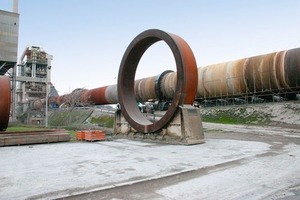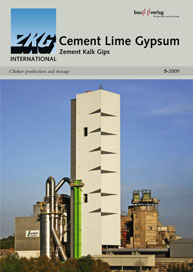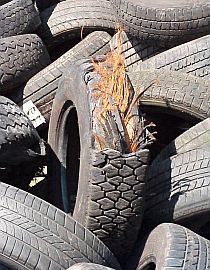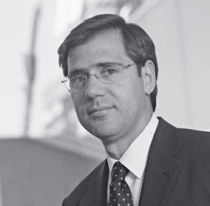Sustainable energy: focus on alternative fuels in the cement industry
What has the potential to reduce CO2 emissions equivalent to that of 10 million cars (approximately the number of cars on the road in Spain)? How can more than 5 million tonnes of non-renewable fossil fuels be saved? The answer is an existing technology: the co-processing of alternative fuels in the European cement industry.
Sustainable Energy Europe (SEE – www.sustenergy.org) is a European campaign to raise awareness and change the landscape of energy. It is a European Commission initiative, and one of the key focal points is the co-processing of alternative fuels. As a Sustainable Energy Europe Campaign (SEE) associate, CEMBUREAU, the European Cement Association, took part in the Sustainable Energy Week (EUSEW, 09.–13.02.09,
Fig. 1).
The European Cement Association based in Brussels is the representative organisation of the cement industry in Europe. Currently, its full members are the national cement industry associations and cement companies of the European Union (with the exception of Cyprus, Malta and Slovakia) plus Norway, Switzerland and Turkey. Croatia is an associate member of CEMBUREAU.
“CEMBUREAU welcomes the recognition afforded to the co-processing of alternative fuels as a form of sustainable energy,” highlights Dr. Jean-Marie Chandelle, Chief Executive of CEMBUREAU. “In addition, we support the European Commission in the pursuit of the wide implementation of sustainable energy development patterns throughout Europe and beyond. Co-processing in the cement industry is an optimum way of recovering energy and material from waste.” Current average EU substitution rates are as follows:
– Alternative fuels 18 %
– Raw materials: 5 %
– Alternative constituents: 12 %
“Co-processing offers a safe and sound solution for the cement industry, the environment and society, by substituting non-renewable resources with waste under strictly controlled conditions,” states Claude Loréa, CEMBUREAU Technical Director. “It provides numerous benefits. Alternative fuels provide a solution in terms of reducing fossil fuel dependency and contributes to the lowering of, in particular, CO2 emissions in other sectors. Alternative raw materials mean a reduced need for quarrying and an improved environmental footprint of such activities. Finally, substitution of clinker in cement is an example of the positive contribution of the European cement industry to efficient resource management.” The EUSEW is the key annual reference point for sustainable energy issues in Europe. The events organized during the EUSEW cover key topics that highlight the multi-sectoral nature of sustainable energy development and stress the need for everyone to work together towards a common goal.
After a few words of introduction and the first lecture given
by employees of Cembureau, three lectures followed focussing on the “Co-processing of raw materials and fuels in the cement industry” (Fig. 2).
In his lecture Jean-Pierre Degré from the Holcim Group dealt with the concept of co-processing of alternative raw materials and fuels. He underlined that co-processing is an issue for all energy-intensive industries.
Evert Mulder from TNO Science and Industry/Netherlands described in his lecture the “Advantages of co-processing” a comprehensive analysis of the properties of various secondary fuels.
Martin Oerter from the German Cement Works Association (VDZ) presented the national point of view in his lecture “Co-processing: the German Experience”. 1.8 million t of coal are substituted by secondary fuels every year. On an average, more than 50 % of the fuels in Germany are substituted by alternative fuels.
The press conference was moderated by Dr. Jean-Marie Chandelle who, after a question-and-answer session, concluded the event with a closing speech.
After the press conference it was possible to take part in a plant tour through the HeidelbergCement works ENCI-Maastricht (Fig. 3) within the framework of the “EU Sustainable Energy
Week”. Frans Erens, Director of ENCI-Maastricht, briefly presented the works. Then the approximately 40 participants had the opportunity to examen the plant more closely. The Maastricht-based cement plant uses 98 % of alternative fuels, the remaining 2 % are needed during the start-up phase of kiln re-commissioning (Figures 4 and 5). 45 % of the alternative fuels used are biomass. Due to an agreement with the local government no hazardous wastes are used. In 1968 the ENCI works had already started to use alternative raw materials and fuels, i. e. shale. At that time approx. 30 % of the fuels for kiln no. 8 were substituted by alternative fuels. More than 30 years, until 1999, coal shale was used as a fuel. Then coal shale was replaced by sewage sludge as alternative fuel. Since 1996 sewage sludge was no longer allowed to be used in agriculture or for landfill in the Netherlands. Thus, 80 000 t/a of sewage sludge are co-incinerated. 2 BioMill plants had been installed for sewage sludge grinding (Fig. 6). Corresponding storage facilities were created for the remaining fuels:
Anode dust – 1 silo
Breeze – 1 silo
Used glycol - 1 tank
Sewage sludge – 6 silos
Meat and bone meal – 1 silo
Fluff – 1 hall + 1 bin
Four Coriolis systems from Schenck Process, one proportioning system from Pfister as well as two weigh-belt feeders have been installed for the exact proportioning of alternative fuels. Furthermore, the laboratory has been designed for quick analyses to be able to determine quickly changes in the composition of the fuel or clinker, respectively.
CEMBUREAU also took the opportunity of this event to launch its latest publication entitled “Sustainable cement production: Co-processing of alternative fuels and raw materials in the cement industry” (Fig. 7).
www.cembureau.eu





